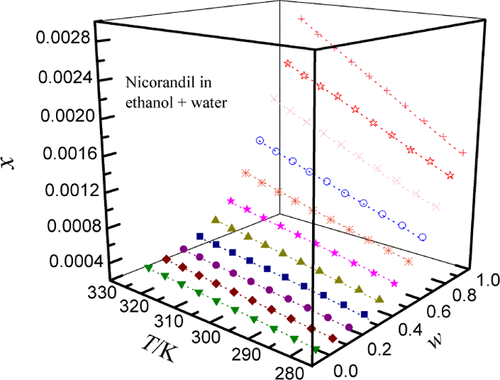当前位置:
X-MOL 学术
›
J. Chem. Eng. Data
›
论文详情
Our official English website, www.x-mol.net, welcomes your
feedback! (Note: you will need to create a separate account there.)
Solubility Determination and Mathematical Modeling of Nicorandil in Several Aqueous Cosolvent Systems at Temperature Ranges of 278.15–323.15 K
Journal of Chemical & Engineering Data ( IF 2.0 ) Pub Date : 2020-07-07 , DOI: 10.1021/acs.jced.0c00370 Jianqiang Zhang 1 , Chunjuan Huang 2 , Renjie Xu 2
Journal of Chemical & Engineering Data ( IF 2.0 ) Pub Date : 2020-07-07 , DOI: 10.1021/acs.jced.0c00370 Jianqiang Zhang 1 , Chunjuan Huang 2 , Renjie Xu 2
Affiliation

|
In the liquid dispersion structure, pure methanol, ethanol, isopropanol, and N,N-dimethyl formamide (DMF) play a major role in dissolution and then water was added in sequence for dilution to obtain a dispersion system with different composition structures, and the concentration gradient between each mixed liquid was 0.1 (mass fraction). The drug nicorandil whose solubility was to be tested is added to it, using the isothermal method, with a high temperature of 323.15 K as the starting point and an interval of 5 K to a low temperature of 278.15 K. The pressure conditions did not require special requirements in an ordinary atmospheric pressure environment (101.1 kPa). Results show that when the temperature approaches the high level, more drugs can be dissolved in the same amount of solvent. Conversely, when the temperature was close to the low level, the drug is more difficult to dissolve. If the temperature was constant and the proportion of the organic solvent was large, the dissolving capacity of the dispersion system will develop in a positive direction. Conversely, if the proportion of water was large, the dissolving power will decrease. Nicorandil crystals accepted the determination of various dissolution data including undissolved raw materials have undergone X-ray power diffraction detection. The results obtained were gratifying, and no change in the crystal structure of the substance was found. Three models—Jouyban–Acree model, Van’t Hoff–Jouyban–Acree model, and modified Apelblat–Jouyban–Acree model—were employed to calculate the experimental nicorandil solubility, and relative average deviation and root-mean-square deviation were no higher than 0.88 and 1.69 × 10–4, respectively. The research on nicorandil is not only a simple measurement of the dissolution data but also more important is that with the support of these data, more thermodynamic data can be calculated to study nicorandil, which is for the improvement of the production process of nicorandil and the synthesis of pharmaceutical preparations is an indispensable link.
中文翻译:

尼古兰地在278.15–323.15 K温度范围内的几种水性助溶剂系统中的溶解度测定和数学模型
在液体分散结构中,纯甲醇,乙醇,异丙醇和N,N-二甲基甲酰胺(DMF)在溶解中起主要作用,然后依次加入水进行稀释以获得具有不同组成结构的分散体系,每种混合液之间的浓度梯度为0.1(质量分数)。使用等温方法,将要测试其溶解度的尼古拉地尔药品加入其中,以323.15 K的高温为起点,以5 K的间隔至278.15 K的低温间隔。压力条件不需要普通大气压环境(101.1 kPa)中的特殊要求。结果表明,当温度接近较高水平时,在相同量的溶剂中可以溶解更多的药物。相反,当温度接近低水平时,药物更难溶解。如果温度恒定且有机溶剂的比例大,则分散体系的溶解能力将向正方向发展。相反,如果水的比例大,则溶解能力将降低。尼古拉地尔晶体接受了各种溶解度数据的测定,包括未溶解的原材料均经过了X射线功率衍射检测。得到的结果令人满足,并且没有发现该物质的晶体结构的变化。使用三种模型(Jouyban–Acree模型,Van't Hoff–Jouyban–Acree模型和改良的Apelblat–Jouyban–Acree模型)来计算实验尼可地尔溶解度,相对平均偏差和均方根偏差均不更高大于0.88和1.69×10 分散系统的溶解能力将朝着积极的方向发展。相反,如果水的比例大,则溶解能力将降低。尼古拉地尔晶体接受了各种溶解度数据的测定,包括未溶解的原料均经过了X射线功率衍射检测。获得的结果令人满足,并且没有发现该物质的晶体结构的变化。使用三种模型(Jouyban–Acree模型,Van't Hoff–Jouyban–Acree模型和改良的Apelblat–Jouyban–Acree模型)来计算实验尼可地尔溶解度,相对平均偏差和均方根偏差均不更高大于0.88和1.69×10 分散系统的溶解能力将朝着积极的方向发展。相反,如果水的比例大,则溶解能力将降低。尼古拉地尔晶体接受了各种溶解度数据的测定,包括未溶解的原料均经过了X射线功率衍射检测。得到的结果令人满足,并且没有发现该物质的晶体结构的变化。使用三种模型(Jouyban–Acree模型,Van't Hoff–Jouyban–Acree模型和改良的Apelblat–Jouyban–Acree模型)来计算实验尼可地尔溶解度,相对平均偏差和均方根偏差均不更高大于0.88和1.69×10 溶解能力会降低。尼古拉地尔晶体接受了各种溶解度数据的测定,包括未溶解的原料均经过了X射线功率衍射检测。得到的结果令人满足,并且没有发现该物质的晶体结构的变化。使用三种模型(Jouyban–Acree模型,Van't Hoff–Jouyban–Acree模型和改良的Apelblat–Jouyban–Acree模型)来计算实验尼可地尔溶解度,相对平均偏差和均方根偏差均不更高大于0.88和1.69×10 溶解能力会降低。尼古拉地尔晶体接受了各种溶解度数据的测定,包括未溶解的原料均经过了X射线功率衍射检测。得到的结果令人满足,并且没有发现该物质的晶体结构的变化。使用三种模型(Jouyban–Acree模型,Van't Hoff–Jouyban–Acree模型和改良的Apelblat–Jouyban–Acree模型)来计算实验尼可地尔溶解度,相对平均偏差和均方根偏差均不更高大于0.88和1.69×10–4分别。尼可地尔的研究不仅是对溶出度数据的简单测量,而且更重要的是,在这些数据的支持下,可以计算出更多的热力学数据来研究尼可地尔,这是为了改善尼可地尔及其制备工艺。药物制剂的合成是必不可少的环节。
更新日期:2020-08-14
中文翻译:

尼古兰地在278.15–323.15 K温度范围内的几种水性助溶剂系统中的溶解度测定和数学模型
在液体分散结构中,纯甲醇,乙醇,异丙醇和N,N-二甲基甲酰胺(DMF)在溶解中起主要作用,然后依次加入水进行稀释以获得具有不同组成结构的分散体系,每种混合液之间的浓度梯度为0.1(质量分数)。使用等温方法,将要测试其溶解度的尼古拉地尔药品加入其中,以323.15 K的高温为起点,以5 K的间隔至278.15 K的低温间隔。压力条件不需要普通大气压环境(101.1 kPa)中的特殊要求。结果表明,当温度接近较高水平时,在相同量的溶剂中可以溶解更多的药物。相反,当温度接近低水平时,药物更难溶解。如果温度恒定且有机溶剂的比例大,则分散体系的溶解能力将向正方向发展。相反,如果水的比例大,则溶解能力将降低。尼古拉地尔晶体接受了各种溶解度数据的测定,包括未溶解的原材料均经过了X射线功率衍射检测。得到的结果令人满足,并且没有发现该物质的晶体结构的变化。使用三种模型(Jouyban–Acree模型,Van't Hoff–Jouyban–Acree模型和改良的Apelblat–Jouyban–Acree模型)来计算实验尼可地尔溶解度,相对平均偏差和均方根偏差均不更高大于0.88和1.69×10 分散系统的溶解能力将朝着积极的方向发展。相反,如果水的比例大,则溶解能力将降低。尼古拉地尔晶体接受了各种溶解度数据的测定,包括未溶解的原料均经过了X射线功率衍射检测。获得的结果令人满足,并且没有发现该物质的晶体结构的变化。使用三种模型(Jouyban–Acree模型,Van't Hoff–Jouyban–Acree模型和改良的Apelblat–Jouyban–Acree模型)来计算实验尼可地尔溶解度,相对平均偏差和均方根偏差均不更高大于0.88和1.69×10 分散系统的溶解能力将朝着积极的方向发展。相反,如果水的比例大,则溶解能力将降低。尼古拉地尔晶体接受了各种溶解度数据的测定,包括未溶解的原料均经过了X射线功率衍射检测。得到的结果令人满足,并且没有发现该物质的晶体结构的变化。使用三种模型(Jouyban–Acree模型,Van't Hoff–Jouyban–Acree模型和改良的Apelblat–Jouyban–Acree模型)来计算实验尼可地尔溶解度,相对平均偏差和均方根偏差均不更高大于0.88和1.69×10 溶解能力会降低。尼古拉地尔晶体接受了各种溶解度数据的测定,包括未溶解的原料均经过了X射线功率衍射检测。得到的结果令人满足,并且没有发现该物质的晶体结构的变化。使用三种模型(Jouyban–Acree模型,Van't Hoff–Jouyban–Acree模型和改良的Apelblat–Jouyban–Acree模型)来计算实验尼可地尔溶解度,相对平均偏差和均方根偏差均不更高大于0.88和1.69×10 溶解能力会降低。尼古拉地尔晶体接受了各种溶解度数据的测定,包括未溶解的原料均经过了X射线功率衍射检测。得到的结果令人满足,并且没有发现该物质的晶体结构的变化。使用三种模型(Jouyban–Acree模型,Van't Hoff–Jouyban–Acree模型和改良的Apelblat–Jouyban–Acree模型)来计算实验尼可地尔溶解度,相对平均偏差和均方根偏差均不更高大于0.88和1.69×10–4分别。尼可地尔的研究不仅是对溶出度数据的简单测量,而且更重要的是,在这些数据的支持下,可以计算出更多的热力学数据来研究尼可地尔,这是为了改善尼可地尔及其制备工艺。药物制剂的合成是必不可少的环节。











































 京公网安备 11010802027423号
京公网安备 11010802027423号